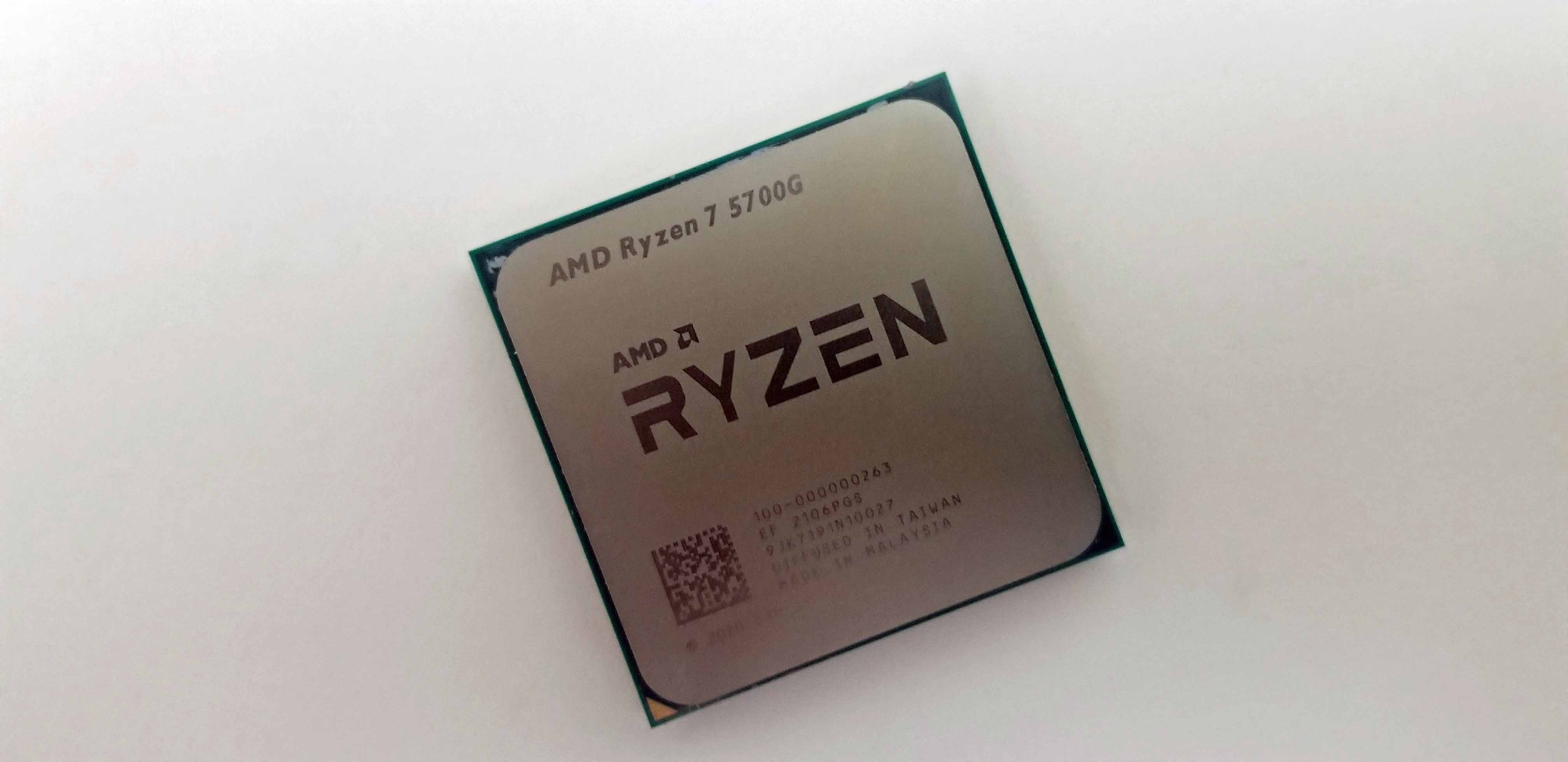Tom's Hardware Verdict
If you're willing to accept lower fidelity and a limited selection of titles, AMD's Ryzen 7 5700G brings unbeatable 1080p and excellent 1280x720 gaming to iGPUs. However, its less expensive sibling, the Ryzen 5 5600G, is a better value.
Pros
- +
+ Faster Zen 3 CPU cores
- +
+ Solid 1080p gaming, excellent 720p
- +
+ Superior power consumption and efficiency
- +
+ Expansive overclocking headroom
- +
+ Bundled cooler
- +
+ Compatible with some AM4 motherboards
Cons
- -
5600G model has better price-to-performance ratio
- -
PCIe 3.0 connectivity
Why you can trust Tom's Hardware
The eight-core 16-thread Ryzen 7 5700G marks the arrival of AMD's first 7nm 'Cezanne' Zen 3 APUs for desktop PCs. AMD plans to use the Cezanne chips to plug big price gaps in its Ryzen 5000 lineup that dominates our Best CPU list and CPU Benchmark hierarchy, but they were previously limited to the OEM market until the full retail launch on August 5, 2021. Anticipation was high, though, so we grabbed an off-the-shelf system from HP to take the Ryzen 7 5700G for a spin for an early look at performance. Now we're back to fill in the final gaps with some additional testing, including CPU overclocking.
The Cezanne chips are the first AMD APUs available at retail since the quad-core Zen+ "Picasso" models landed back in 2019. AMD actually replaced its Picasso chips with the eight-core Zen 2-powered Ryzen Pro "Renoir" series in 2020, but in a disappointing development, it reserved those chips for OEMs. Unfortunately, that means APUs with the aging Zen+ architecture were the best you could find at retail, even though AMD has already progressed through three chip generations in the interim (Zen 2, XT, Zen 3).
| CPU | Arch. | Price | Cores/ Threads | Base/ Boost Freq. | GPU Cores | GPU Freq. (MHz) | TDP | L3 (MB) |
| Ryzen 7 5700G | Zen 3 | $359 | 8 / 16 | 3.8 / 4.6 | RX Vega 8 | 2000 | 65W | 16 |
| Ryzen 5 5600G | Zen 3 | $259 | 6 / 12 | 3.9 / 4.4 | RX Vega 7 | 1900 | 65W | 16 |
| Ryzen 3 5300G | Zen 3 | N/a | 4 / 8 | 4.0 / 4.2 | RX Vega 6 | 1700 | 65W | 8 |
AMD's decision to keep those chips off the retail market couldn't have come at a worse time. The pandemic triggered an unprecedented PC upgrade cycle right as supply chain disruptions and component shortages rocked the globe and cryptomining reemerged, all conspiring to create the most severe GPU shortage in history. With discrete GPUs nowhere to be found, the Renoir chips and their serviceable integrated GPUs would have been a godsend for gamers looking to wait out the GPU shortage, but the shortage found even AMD's last-gen Picasso chips disappearing entirely from shelves.
AMD launched its Ryzen 5000 chips in the interim, but the company's pivot to premium pricing exposed two weaknesses in its product stack, including a steep $300 minimum price of entry to the Zen 3 family and a big $150 gap between its Ryzen 5 and Ryzen 7 families. Unfortunately for AMD, Intel's Rocket Lake blasted in a few months ago and plugged those pricing gaps, catching AMD uncharacteristically flat-footed.
The Cezanne APUs, which come with Zen 3 execution cores paired with the Radeon Vega graphics engine, look to solve several problems at once. Instead of its traditional separation of the CPU and APU lines, AMD slots the Cezanne chips right into its Ryzen 5000 stack — AMD says they fill the role of the standard "non-X" models that traditionally offer more attractive price points at a given core count by sacrificing peak clock speed for a lower TDP. That means the 5700G should essentially slot in as a Ryzen 7 5800, which doesn't make a lot of sense given that AMD actually has a Ryzen 7 5800 that is OEM-only. We'll dive into that a bit more later.
According to AMD, Cezanne is the cure for all of Ryzen 5000's pricing ills, with the $359 eight-core 16-thread Ryzen 7 5700G plugging the gulf between the Ryzen 7 and 5 lineups, while the $259 six-core Ryzen 5 5600G reduces the steep price of entry to the Zen 3 lineup. Both chips also come with a bundled Wraith Stealth cooler, sweetening the deal.
AMD is still holding back several of its lower-end APUs from the retail market, but given the ongoing graphics card shortages, the Cezanne APUs could be a welcome sight for the gaming market. That is if the chips actually slot in between the performance of their Ryzen counterparts. That's a tall order given that the tradeoffs associated with their monolithic die design, which differs significantly from the chiplet-based Ryzen 5000 chips. Let's see how it all works out.
Get Tom's Hardware's best news and in-depth reviews, straight to your inbox.
The Overall Benchmark TLDR:
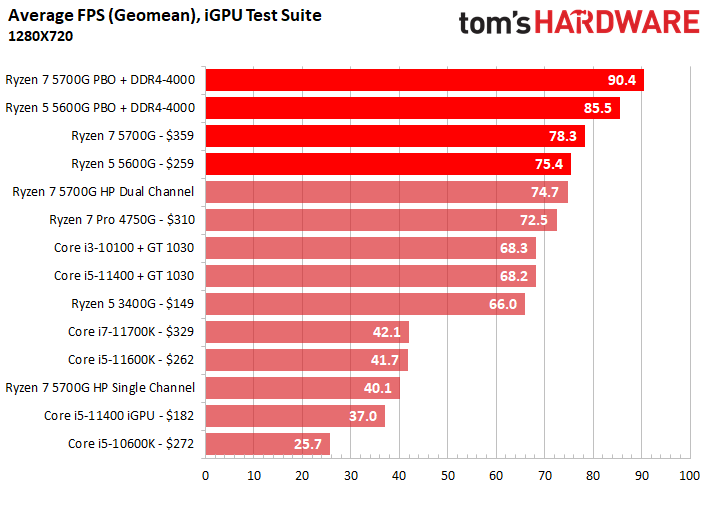
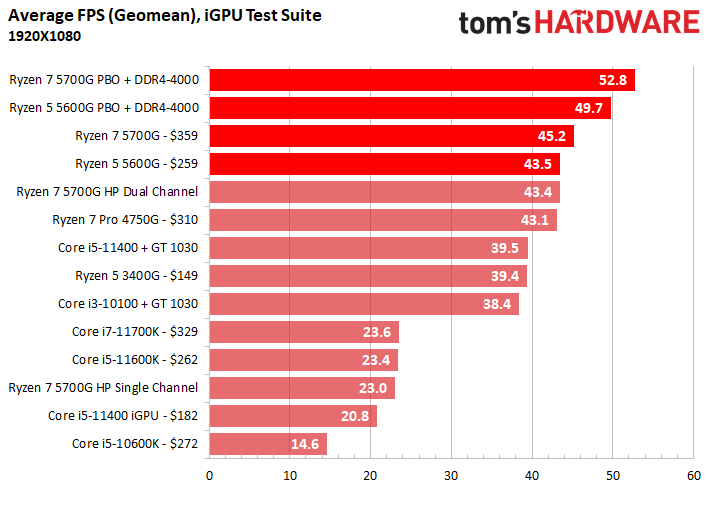
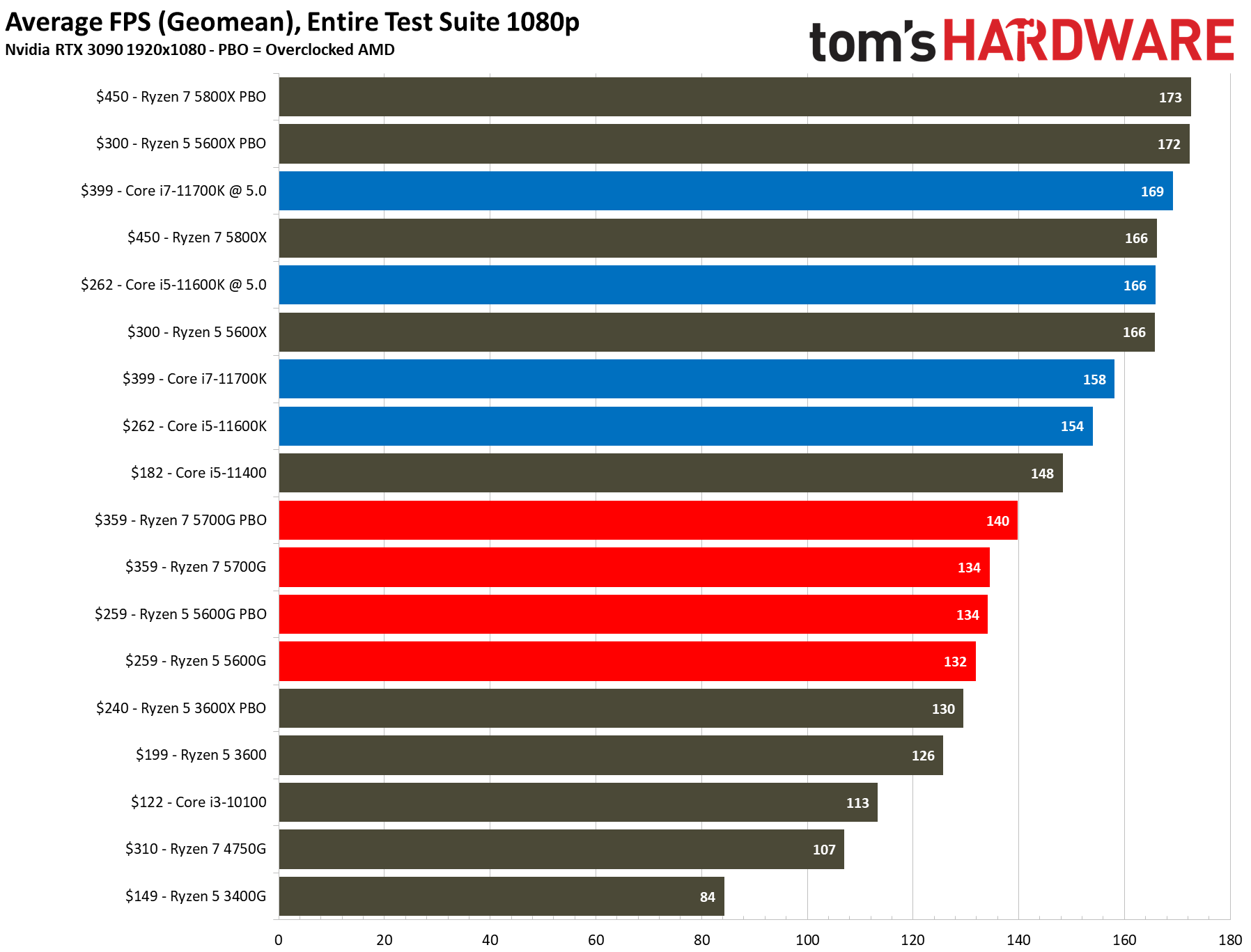
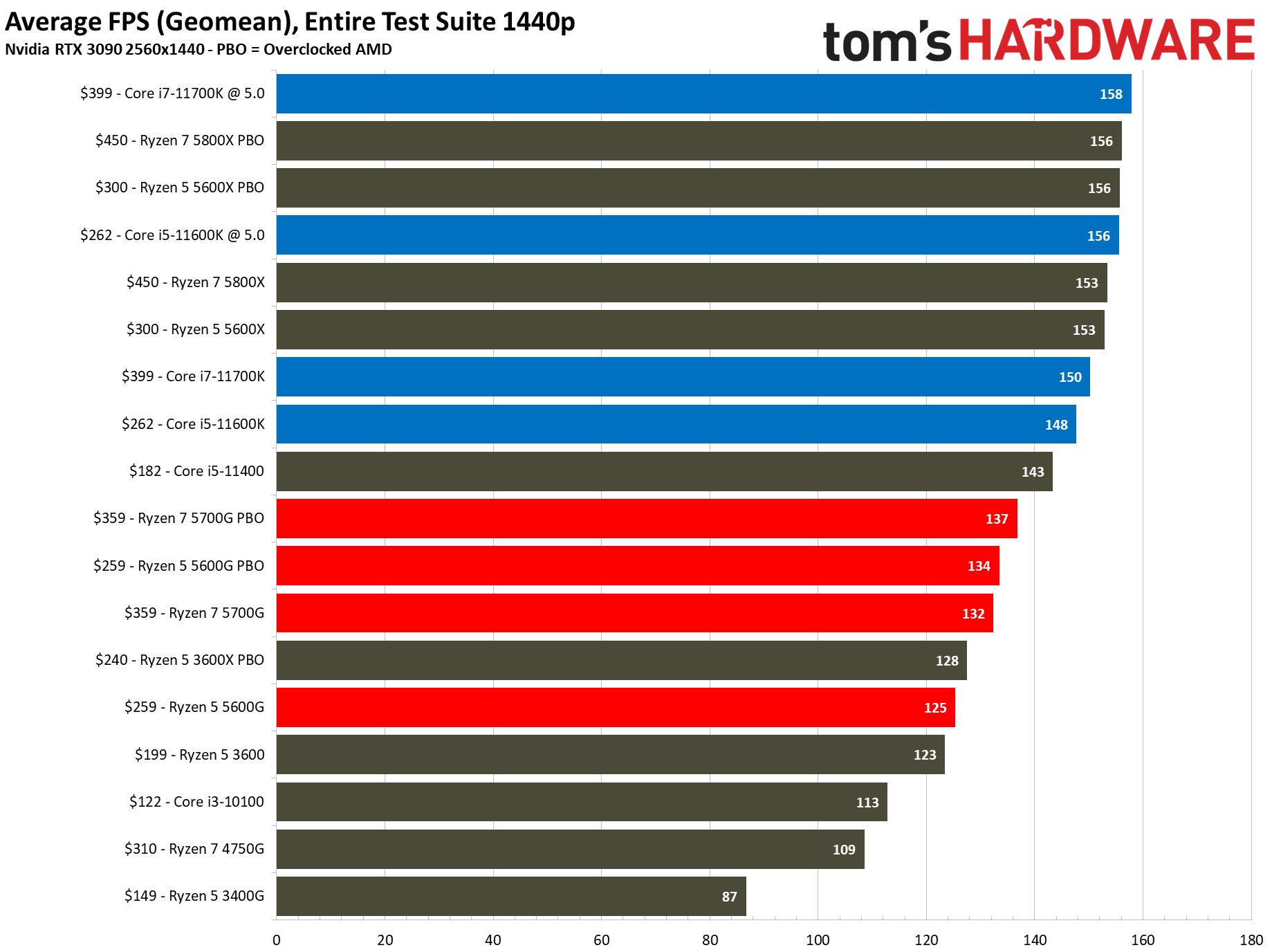
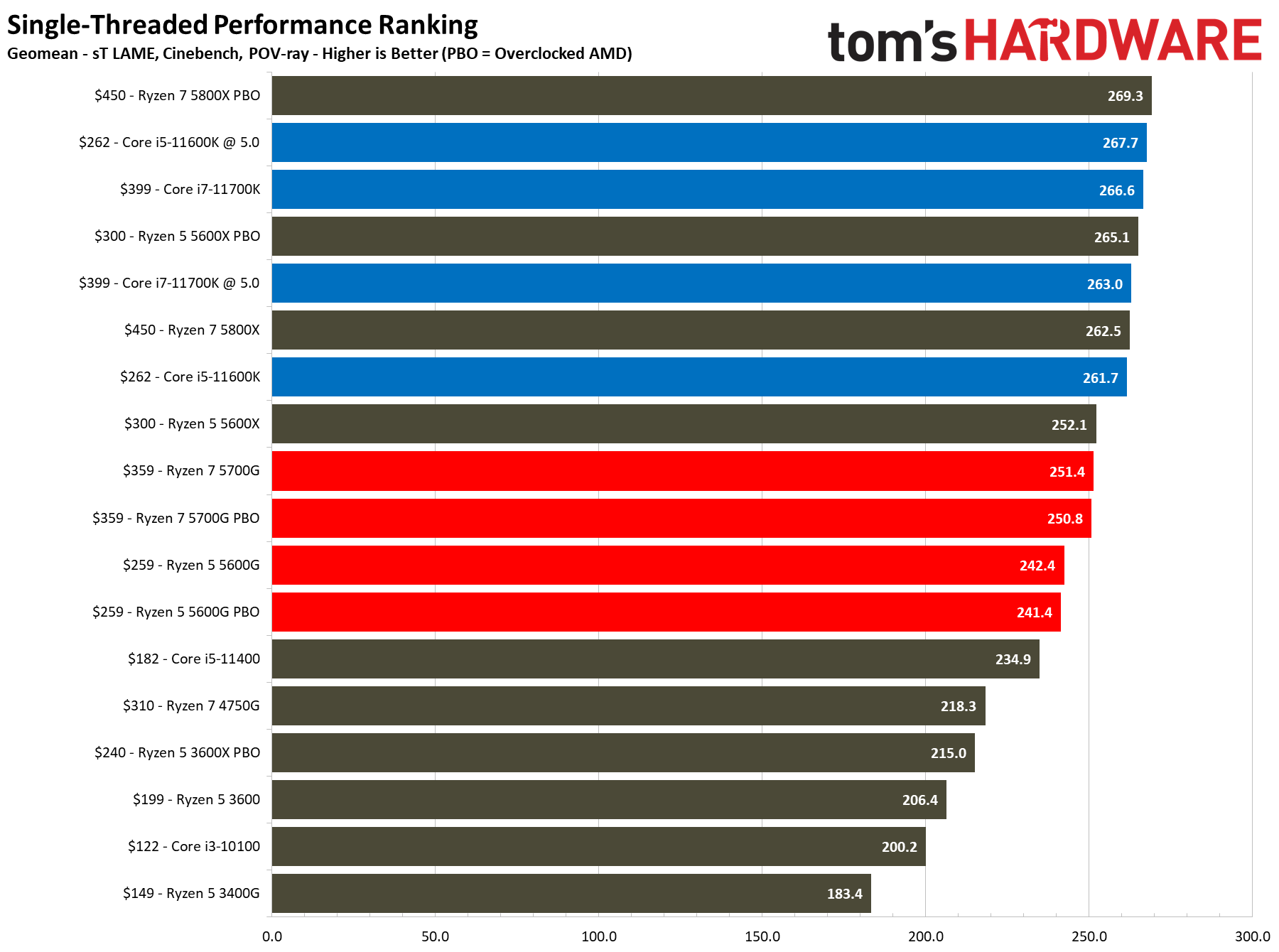
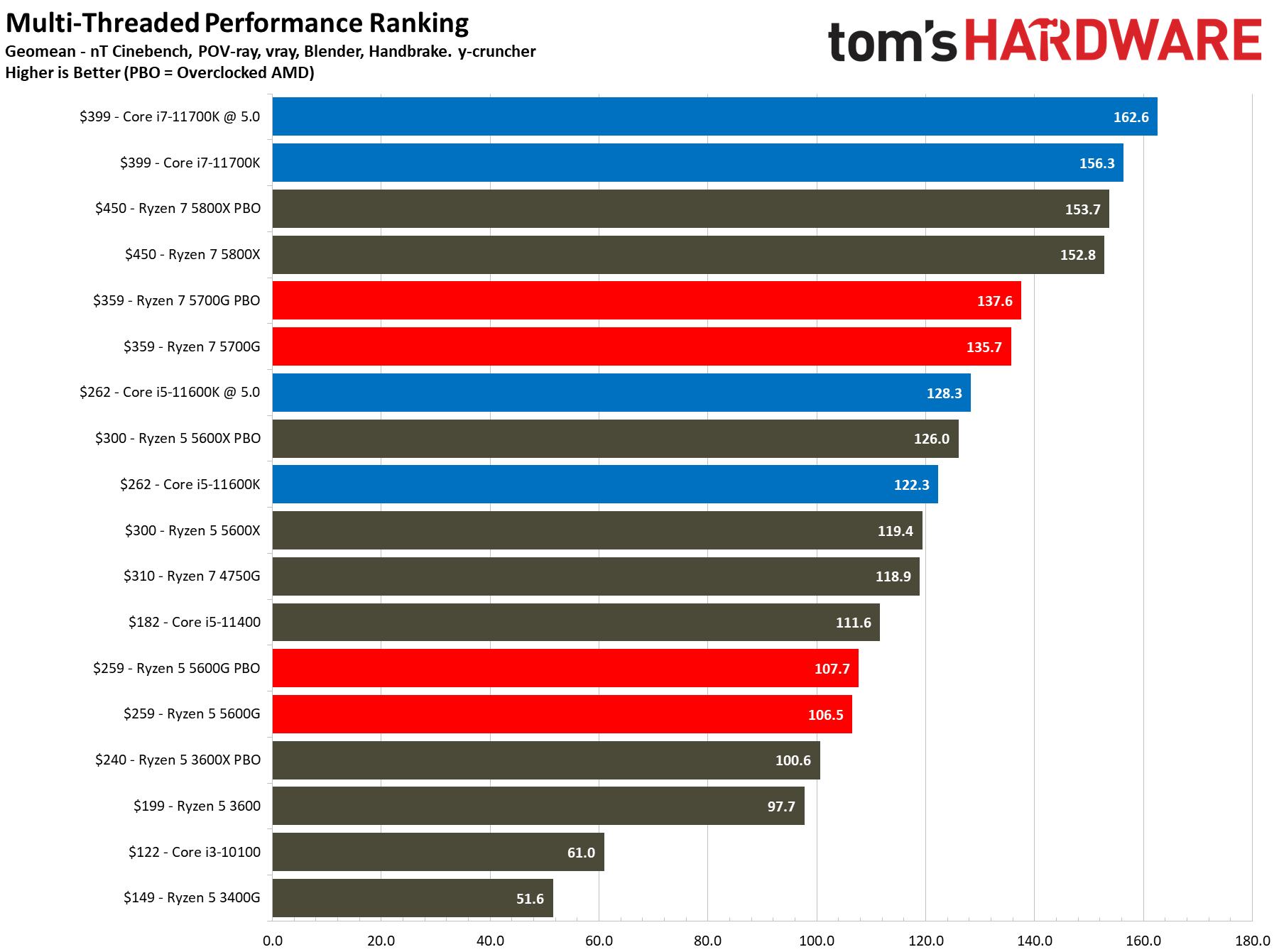
We'll go over the various benchmarks behind these cumulative results in great depth on the following pages, but these slide provide a quick summation of our test results. The first two slides show gaming performance with the integrated GPU and the second two slides show performance when you pair the chips with a discrete GPU. The final two slides show performance in both single- and multi-threaded applications. Be sure to hit the following pages for a more in-depth look at the results, and the final page for our overall analysis.
AMD Ryzen 7 5700G Specifications and Pricing
The Ryzen 5000G family spans from four to eight cores and has the Zen 3 architecture that provides a 19% IPC uplift over the Zen 2 architecture used in the previous-gen Ryzen 4000G models. AMD is only bringing the eight-core 16-thread Ryzen 7 5700G and six-core 12-thread Ryzen 5 5600G to retail, at least for now. In addition, AMD currently hasn't announced when it will bring the four-core eight-thread Ryzen 3 5300G or the 35W GE-Series models to retail. The didn't stop us from grabbing a Ryzen 3 5300G and putting it through our test suite, though. However, we won't see any significant change to our list of Best Cheap CPUs any time soon.
| CPU | Arch. | Price | Cores/ Threads | Base/ Boost Freq. | TDP | L3 (MB) | GPU Cores | GPU Freq. (MHz) |
| Ryzen 7 5800X | Zen 3 | $449 | 8 / 16 | 3.8 / 4.7 GHz | 105W | 32 (1x32) | N/a | N/a |
| Core i7-11700K (KF) | Rocket Lake | $374 - $349 | 8 / 16 | 3.6 / 5.0 | 125W | 16 | UHD Graphics 750 Xe 32EU | 1300 |
| Ryzen 7 5700G | Zen 3 | $359 | 8 / 16 | 3.8 / 4.6 | 65W | 16 | RX Vega 8 | 2000 |
| Ryzen 7 4750G | Zen 2 | ~$310 | 8 / 16 | 3.6 / 4.4 | 65W | 8 | RX Vega 8 | 2100 |
| Ryzen 5 5600X | Zen 3 | $299 | 6 / 12 | 3.7 / 4.6 GHz | 65W | 32 (1x32) | N/a | N/a |
| Core i5-11600K (KF) | Rocket Lake | $262 (K) - $237(KF) | 6 / 12 | 3.9 / 4.9 | 125W | 12 | UHD Graphics 750 Xe 32EU | 1300 |
| Ryzen 5 5600G | Zen 3 | $259 | 6 / 12 | 3.9 / 4.4 | 65W | 16 | RX Vega 7 | 1900 |
| Ryzen 5 3600 | Zen 2 | $200 | 6 / 12 | 3.6 / 4.2 | 65W | 32 | N/A | N/a |
| Core i5-11400 (F) | Rocket Lake | $182 - $157 | 6 / 12 | 2.6 / 4.2 | 65W | 12 | UHD Graphics 750 Xe 24EU | 1300 |
| Ryzen 3 5300G | Zen 3 | N/a | 4 / 8 | 4.0 / 4.2 | 65W | 8 | RX Vega 6 | 1700 |
| Ryzen 5 3400G | Zen+ | $149 | 4 / 8 | 3.7 / 4.2 | 65W | 4 | RX Vega 11 | 1400 |
The 65W eight-core 16-thread Ryzen 7 5700G comes with a 3.8 GHz base and a 4.6 GHz boost clock, 16MB of L3 cache, and eight Radeon RX Vega CUs that operate at 2.0 GHz. As with all Zen 3 processors, the Ryzen 5000G chips step up from DDR4-2933 to DDR4-3200 interface, which will help boost gaming performance with the integrated GPU. Compared to the eight-core Ryzen 7 5800X, you gain the Radeon graphics engine but sacrifice 100 MHz of peak boost clocks and half the L3 cache. You also step back from 24 lanes of PCIe 4.0 support to 20 lanes of PCIe 3.0.
AMD is quite adamant that the Ryzen 5000G chips serve as the new "non-X" models for the Zen 3 family. The $359 Ryzen 7 5700G plugs the sizeable $150 gap between the $449 Ryzen 9 5800X and $299 Ryzen 5 5600X. That gap left Intel's Core i7-11700K room to operate, but AMD says the 5700G's performance slots perfectly between the other Ryzen 5000 parts and brings the advantage of the integrated Vega graphics engine. The 65W six-core 12-thread Ryzen 5 5600G comes with a 3.9 GHz base, 4.4 GHz boost, and seven Radeon Vega CUs that operate at 1.9 GHz. We already have a review of the Ryzen 5 5600G here, and we'll update it with our additional overclocking tests now that the NDA has expired. However, you can see all of the additional tests in this article, too.
The $256 5600G plugs the gap between the $299 Ryzen 5 5600X and, well, AMD's entire sub-$299 product stack. AMD's aging Ryzen 5 3600 is the only real relevant contender in this price range, and it isn't competitive with Intel's Rocket Lake Core i5-11600K or Core i5-11400, leaving Intel to reign uncontested in the budget market (as you can see in our recent 11400 vs 3600 faceoff). Based on suggested pricing, the 5600G grapples with the Core i5-11600K, but AMD has yet to address the current value budget champ, the Intel Core i5-11400.
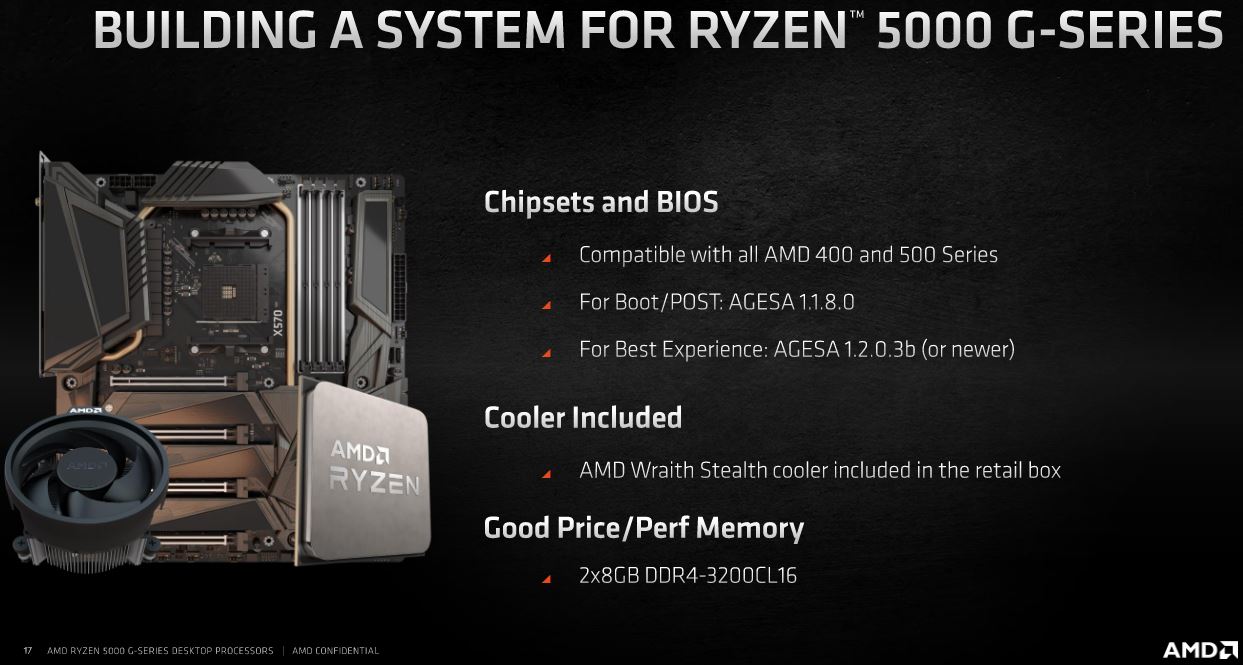
AMD Ryzen 7 5700G Cezanne Architecture
AMD's official Cezanne launch doesn't have as much deep-dive information as usual, but that's because most of the architecture is already known: AMD uses the same SoC for the Ryzen 5000 mobile chips and the Ryzen 5000G desktop PC APUs.
The majority of the Ryzen 5000G 'Cezanne' SoC comes from the Ryzen 4000 'Renoir' SoC because AMD essentially swapped in new Zen 3 cores, leaving the I/O, 7nm Radeon RX Vega integrated graphics engine and SoC design intact, thus improving time to market.
Naturally, the chip has much more thermal and power headroom in a desktop PC, so AMD tunes multiple variables to tailor the chips for both unique segments, like power consumption, boosting algorithms, and power-sharing between the CPU and GPU. You can read much more about the design and architecture in our AMD Ryzen 5000 Mobile 'Cezanne' SoC Deep Dive.
AMD reused the Renoir SoC design, so the 5700G comes with the 7nm Radeon RX Vega graphics engine with eight CUs, and not a newer RDNA-based design. AMD has dialed back the 5700G's iGPU by 100 MHz compared to the previous-gen 4750G but increased the CPU base/boost clock rates by 200 MHz, suggesting that it tuned the SoC for an optimal balance of CPU and GPU horsepower. AMD had already reworked the graphics architecture for its last go-round with Renoir — the reworked 7nm RX Vega graphics delivered up to 60% percent more performance per compute unit (CU) than its predecessors, equating to more graphics performance from fewer CU.
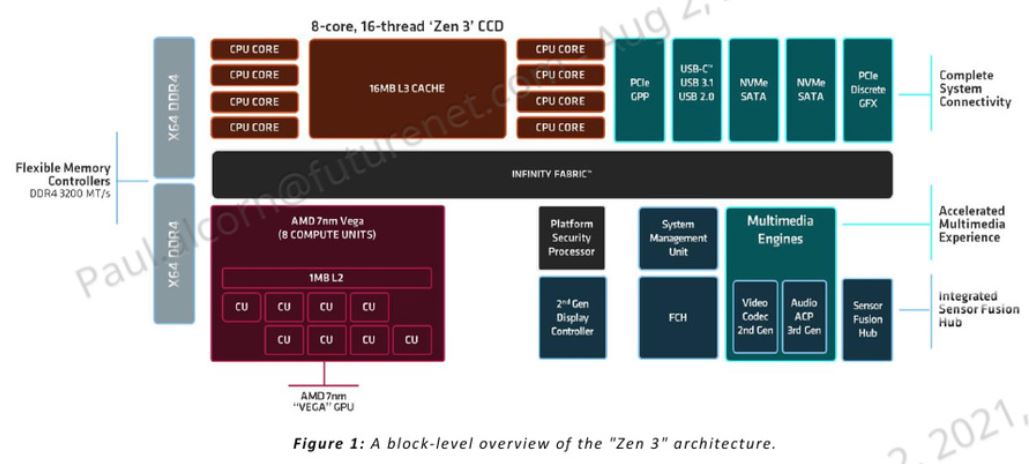
Ryzen 5000G’s monolithic die allows for tighter control of power efficiency and other important characteristics for the mobile space, but it also introduces a few tradeoffs compared to the desktop chips that have a chiplet-based design. For example, unifying all the I/O, cache, and CPU cores, not to mention adding GPU cores, onto a single die inevitability resulted in some sacrifices to meet the company's performance, power, and area (PPA) targets.
For instance, the Ryzen 7 5700G has 16MB of L3 cache, but that's half the L3 capacity of the chiplet-based Ryzen 7 5800X for desktop PCs that also comes with eight cores. However, Cezanne does improve over the Renoir APUs — the 5700G has twice the L3 of the eight-core 4750G.
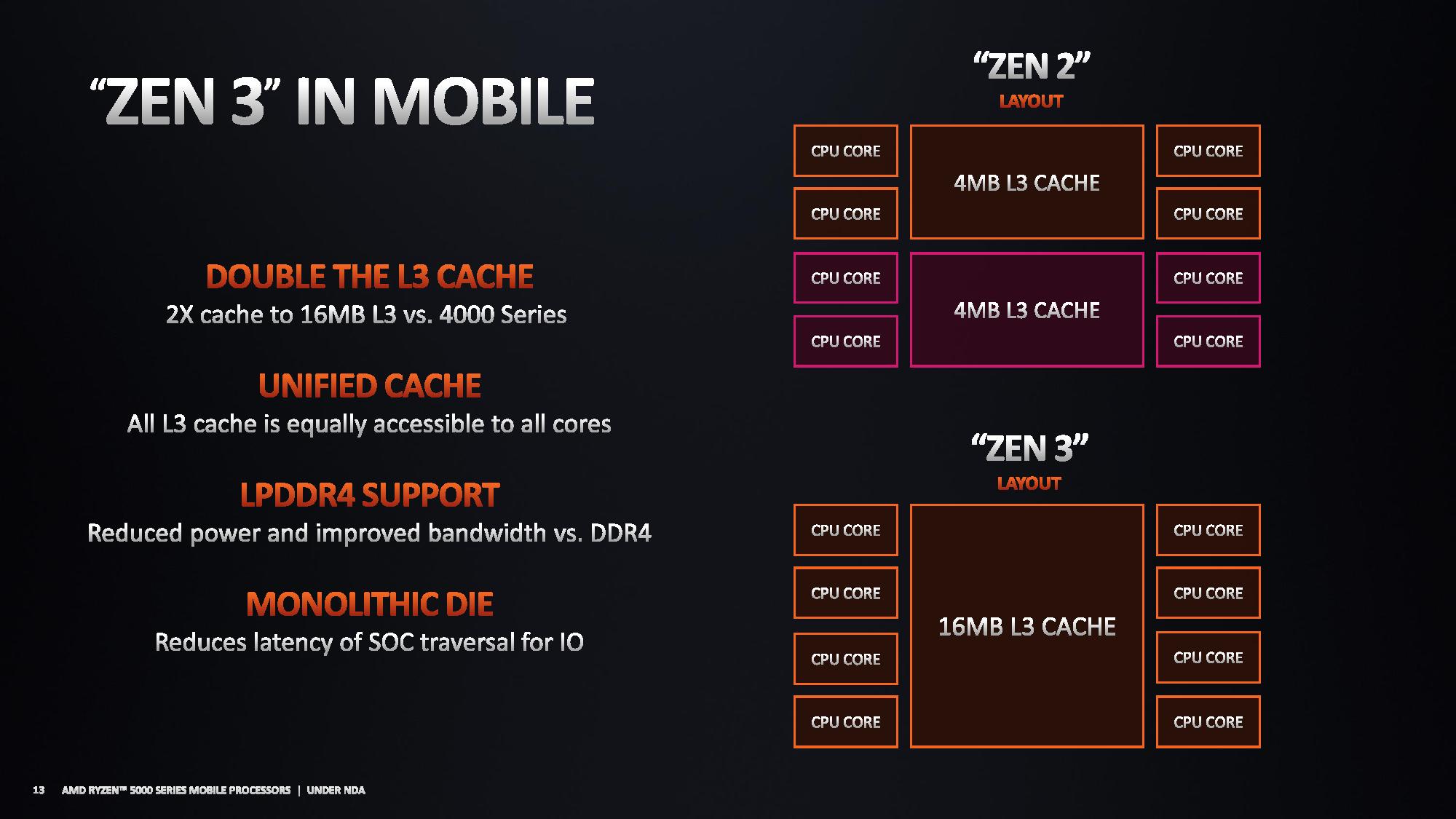
AMD also unified the eight cores and cache into one contiguous 16MB cluster inside the CCX (Core Complex). In contrast, Zen 2 had two four-core clusters, each with 4MB of cache. This larger unified cache improves both core-to-cache and core-to-core latency over the Renoir chips. In addition, for highly-threaded applications, this imparts a 2X cache increase, and lightly-threaded workloads now have access to a full 16MB of cache, equivalent to a 4X increase in directly-accessible cache.
Re-using the Renoir SoC design also means that AMD has stuck with the PCIe 3.0 interface found on all its current-gen APUs. As such, the chip has 20 lanes of PCIe 3.0 connectivity (16 for graphics, four for the chipset, and four for storage) compared to 24 lanes of PCIe 4.0 found on the Ryzen 5000 models for the desktop PC.
The Cezanne desktop chips will find their way into 500-series and some 400-series motherboards, though support on the latter will vary by vendor.
- MORE: Best CPUs for Gaming
- MORE: CPU Benchmark Hierarchy
- MORE: AMD vs Intel
- MORE: Zen 4 Ryzen 7000 All We Know
- MORE: How to Overclock a CPU
- MORE: How to check CPU Temperature
Current page: Ryzen APUs Level Up
Next Page AMD Ryzen 7 5700G Power Consumption, Overclocking and Thermals
Paul Alcorn is the Editor-in-Chief for Tom's Hardware US. He also writes news and reviews on CPUs, storage, and enterprise hardware.
-
lazyabum Great. Integrated GPUs are being pushed for high-end graphics over the lack of Discrete GPUsReply -
hotaru251 amd had the chance to crush intel's low end if they just had more modern apu inside...let vega die already. its 2021.Reply -
AlexWolfheart Clearly the guy that wrote this piece and declared it "the fastest integrated graphics ever" has rather limited knowledge.Reply
Amd (and Intel, working together) has an old integrated Vega that's close in performance to a gtx1060, basically obliterating the 5700G:
Intel 8809G with the Radeon M GH igpu (found inside intel hades canyon nuc)
It may not be a user replaceable apu, but it IS an igpu that can easily demolish this one in terms of performance. But then again, the clickbait title wouldn't be as good as this, now, would it? :) -
Jim90 Reply
But they ARE crushing the igpu competition...and they're showing they don't need higher than this for that.hotaru251 said:amd had the chance to crush intel's low end if they just had more modern apu inside...let vega die already. its 2021.
Once the competition catches up then, and only then, will they integrate their other choices. From a business point of view this is eminently reasonable, as much as we'd all like integrated rdna2/3 now. -
AlexWolfheart ReplyJim90 said:But they ARE crushing the igpu competition...and they're showing they don't need higher than this for that.
Once the competition catches up then, and only then, will they integrate their other choices. From a business point of view this is eminently reasonable, as much as we'd all like integrated rdna2/3 now.
So, in short, they're greedy, not offering their best because of weaker competition.
If you were hoping to defend AMD, this argument did worse ... -
King_V Reply
Where did you get the performance numbers that back this? I haven't been able to find any solid reviews on this.AlexWolfheart said:Clearly the guy that wrote this piece and declared it "the fastest integrated graphics ever" has rather limited knowledge.
Amd (and Intel, working together) has an old integrated Vega that's close in performance to a gtx1060
(not looking for YouTube videos, but article reviews with charts and such) -
fball922 Reply
Companies exist to make money, and to make as much money (legally) while expending the smallest amount of money possible, so I guess that is greedy? Doing what they are supposed to do? This is literally what every market does. If you were trying to shame AMD for not putting in an iGPU in that makes you feel warm fuzzies, this argument did worse... Of course, if they had gone the route of upgrading the iGPU, then raised the price of the APU, we would probably hear moaning and groaning about how they shouldn't raise the price because it's so greedy of them.AlexWolfheart said:So, in short, they're greedy, not offering their best because of weaker competition.
If you were hoping to defend AMD, this argument did worse ... -
AlexWolfheart ReplyKing_V said:Where did you get the performance numbers that back this? I haven't been able to find any solid reviews on this.
(not looking for YouTube videos, but article reviews with charts and such)
Have you tried... Google?
I've got the performance numbers both from google, but also from actually owning a NUC8i7HVK as my bedroom media pc, but here, i'll post links for you, since it's so hard to find info:
https://www.tomshardware.com/reviews/intel-hades-canyon-nuc-vr,5536.html
https://www.gamersnexus.net/hwreviews/3282-hades-canyon-review-intel-amd-pressure-nvidia-nuc8i7hvk
https://www.notebookcheck.net/Intel-Hades-Canyon-NUC8i7HVK-i7-8809G-Radeon-RX-Vega-M-GH-Mini-PC-Review.290800.0.html
https://www.anandtech.com/show/12572/the-intel-hades-canyon-nuc8i7hvk-review-kaby-lakeg-benchmarked
As I said before: yes, it is not a user replaceable APU, but it is an integrated gpu from over 2 years ago that still mops the floor with all other igpus. -
AlexWolfheart Reply
Given amd's very low market share in terms of gpus, but decently growing cpu market share, going all in and releasing a cpu with a very powerful igpu would be a good marketing decision, to make them sell even more, and make less people buy Nvidia.fball922 said:Companies exist to make money, and to make as much money (legally) while expending the smallest amount of money possible, so I guess that is greedy? Doing what they are supposed to do? This is literally what every market does. If you were trying to shame AMD for not putting in an iGPU in that makes you feel warm fuzzies, this argument did worse... Of course, if they had gone the route of upgrading the iGPU, then raised the price of the APU, we would probably hear moaning and groaning about how they shouldn't raise the price because it's so greedy of them.
Amd could, in theory, with rdna2 integrated, like the xbox series something and ps5, it could make customers not need to buy an rtx3060 (ti or simple), and thus, keep more marketshare for themselves ;) -
greenreaper With RDNA2 coming in 2022, and prices still abnormally high, it's hard to recommend this as an APU unless you need it now or don't care about the new architecture's boosts in power/perf - or having some level of hardware raytracing support.Reply
To me, having feature parity with the latest consoles is important, because that'll help as many games work on it as possible, even if they don't work as fast. The big question for me is whether RDNA2 will work as well without the large cache in its discrete editions.
